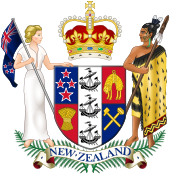- Crown Minerals Act 1991
-
Crown Minerals Act 1991 
Parliament of New ZealandLong title/
PurposeAn Act to restate and reform the law relating to the management of Crown owned minerals Administered by Ministry of Economic Development
(formerly the Ministry of Commerce)Dates Date passed 1991 Commencement 1 October, 1991 Other legislation Status: Current legislation The Crown Minerals Act is an Act of Parliament passed in 1991 in New Zealand. It controls the management of Crown owed minerals. Potential changes to Schedule 4 of the Act created controversy and opposition in 2010. The definition of minerals under the Act is very broad - it includes gravel, industrial rocks, building stone, coal and petroleum.
All gold, silver, uranium and petroleum is under Crown ownership as well as any other minerals that are on Crown owned land.[1]
Schedule 4
In 2009 the National-led government announced that it would review Schedule 4 of the Act, a list of areas for which access for mining is not granted by the Minister of Conservation. The proposal was condemned by critics not only because of the potential environmental impacts, but also because of the associated effects that were feared for the tourism industry.[2]
Major NGOs such as Federated Mountain Clubs[3] and Forest and Bird came out in opposition to the plans.
In March 2010 the government requested public feedback on a discussion document on the removal of 7000 ha of land from Schedule 4.[4] There was a record 37,500 submissions on the document. A protest March Against Mining was organised by Greenpeace NZ on 1 May in Auckland [5] and it attracted an estimated 40,000 people.[6]
On 20 July 2010 the Government announced that in response to receiving 37,552 submissions, the vast majority of which opposed mining, it will not remove any land from Schedule 4.[7]
See also
References
- ^ A guide to the Crown Minerals Act 1991. NZ: Ministry of Commerce. January 1992. ISBN 0-478-00489-3.
- ^ "Robyn Malcolm: NZ image about to be gutted 'surgically'". The New Zealand Herald. 24 March 2010. http://www.nzherald.co.nz/nz/news/article.cfm?c_id=1&objectid=10634013. Retrieved 24 March 2010.
- ^ FMC Bulletin, Federated Mountain Clubs, November 2009, ISSN 0110-6120, http://fmc.org.nz/wp-content/uploads/2009/09/2009_11_Bulletin_178.pdf, retrieved 9 August 2010
- ^ "Schedule 4 stocktake". Ministry of Economic Development. http://www.med.govt.nz/templates/StandardSummary____42577.aspx. Retrieved 23 March 2010.
- ^ "March Against Mining". Greenpeace NZ. http://www.dontunderminenz.org. Retrieved 19 April 2010.
- ^ "Thousands march in protest against mining". Radio New Zealand. 1 May 2010. http://www.radionz.co.nz/news/stories/2010/05/01/1248033a45ec. Retrieved 1 May 2010.
- ^ "No land to be removed from Schedule 4" (Press release). New Zealand Government. 2010-07-20. http://www.beehive.govt.nz/release/no+land+be+removed+schedule+4. Retrieved 2010-07-20.
Further reading
- Bain, Helen (February 2010). "Mining New Zealand's green heart". Forest and Bird (Royal Forest and Bird Protection Society of New Zealand) (335). ISSN 0015-7384. http://www.forestandbird.org.nz/what-we-do/publications/forest-bird-magazine/articles-archive/mining-new-zealands-green-heart.
External links
Categories:- New Zealand Statutes
- 1991 in New Zealand
- 1991 in law
- Mining in New Zealand
Wikimedia Foundation. 2010.
